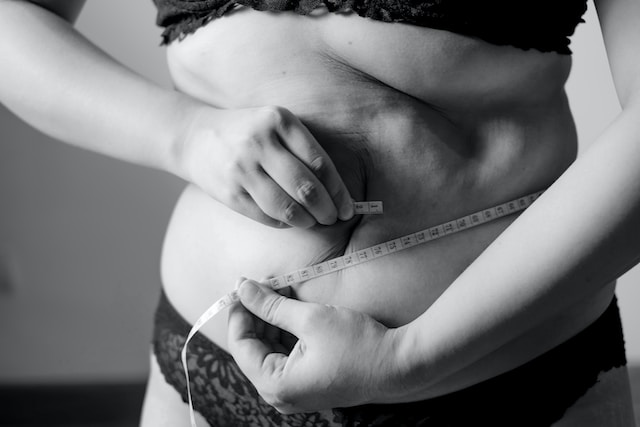Why Do I Look Fatter After Working Out?
When people start working out to lose weight, they expect to see a slimmer figure in the mirror. However, some may notice that they look even fatter than before they started exercising. This can be frustrating and confusing, especially when they are putting in the effort to get in shape. So, why does this happen?
One possible explanation is that the body is retaining water after a workout. When a person exercises, their muscles produce heat, which causes them to sweat. Sweating is the body’s way of cooling down, but it also leads to a loss of fluids.
To compensate for this, the body may hold onto water, which can make a person look bloated and puffy. This effect is usually temporary and should go away within a few hours or days.
Understanding Body Composition
Body composition refers to the different types of tissues that make up a person’s body, including muscle, fat, bone, and water. Understanding body composition is important because it can help explain why a person may look fatter after working out.
It is a common misconception that muscle weighs more than fat. The truth is that a pound of muscle and a pound of fat weigh the same – one pound. Nonetheless, muscle is denser than fat, and as a result, it occupies less space in the body. This is why an individual with a greater percentage of muscle may seem leaner, despite having the same weight as someone with a higher percentage of body fat.
Another factor that can contribute to a person looking fatter after working out is water retention. When a person exercises, their muscles may become inflamed and retain water as a result. This can cause temporary bloating and swelling, which may make a person appear larger.
It is essential to understand that weight loss and fat loss may not necessarily be equivalent.When a person loses weight, they may be losing a combination of fat, muscle, and water. This is why it’s important to track body composition changes, rather than just weight, to get a more accurate picture of progress.
The Role of Muscle Gain
When someone starts working out, they may notice that they look fatter despite losing weight. This can be attributed to muscle gain. Muscle weighs more than fat, so as someone builds muscle, their weight may increase. However, this does not necessarily mean they are getting fatter.
Muscle gain can also affect the way someone’s body looks. As muscles grow, they can push against fat, making it appear more prominent. This can give the illusion of getting fatter, even though the person is actually losing fat and gaining muscle.
It’s important to note that muscle gain is a positive thing. Not only does it increase strength and endurance, but it also boosts metabolism. This means that even at rest, someone with more muscle will burn more calories than someone with less muscle.
Water Retention and Weight Gain
One possible reason why someone might look and feel fatter after working out is water retention. When someone exercises, their muscles need more energy, and this energy comes from stored glycogen in the muscles.
Glycogen is made up of glucose and water, and when it is used for energy, the water is released into the body. This extra water can lead to temporary weight gain and bloating.
In addition to this, exercise can also cause the body to produce more cortisol, a hormone that is associated with stress. Retention of water in the body due to cortisol can result in temporary weight gain as well. This effect is more pronounced in people who are already overweight or obese.
It’s important to note that water retention is not the same as fat gain. Fat gain occurs when someone consumes more calories than they burn, and the excess calories are stored as fat. Water retention, on the other hand, is a temporary increase in the amount of water in the body, and it can be caused by a variety of factors, including exercise.
To help reduce water retention, it’s important to stay hydrated and to avoid consuming too much salt. Drinking plenty of water can help flush excess water out of the body, while reducing salt intake can help prevent the body from retaining too much water.
Additionally, incorporating strength training into a workout routine can help build muscle, which can help improve body composition and reduce the appearance of bloating.
The Impact of Diet
Diet plays a significant role in how a person’s body responds to exercise. Consuming a high-calorie diet, even when exercising regularly, can lead to weight gain and a larger appearance. Hence, it is important to maintain a balanced diet that meets the body’s nutritional needs.
Protein is an essential nutrient for muscle growth and repair. Consuming an adequate amount of protein can help maintain muscle mass and reduce the appearance of fat. Foods such as lean meats, fish, eggs, and legumes are excellent sources of protein.
Carbohydrates are also an important nutrient for energy during exercise. However, consuming too many carbohydrates can lead to weight gain. Selecting complex carbohydrates like whole grains, fruits, and vegetables is crucial as they offer long-lasting energy and are less likely to be stored as fat.
Foods high in fat and sugar should be consumed in moderation. These foods are often high in calories and can lead to weight gain and a larger appearance. It is recommended to limit consumption of processed foods, sugary drinks, and snacks.
Workout Intensity and Fat Appearance
The intensity of a workout can affect how one’s body appears after exercising. High-intensity workouts that involve weight lifting or resistance training can cause temporary inflammation and swelling in the muscles.
This inflammation can cause the muscles to appear larger, giving the impression of a bulkier frame. While this inflammation is temporary and will subside in a few days, it can be mistaken for an increase in body fat.
In contrast, low-intensity workouts such as yoga or Pilates can help reduce inflammation and swelling in the body. These types of workouts focus on stretching and lengthening the muscles rather than building them up. As a result, the body may appear leaner and more toned after a low-intensity workout.
It is important to note that the appearance of fat on the body can also be affected by factors such as diet and hydration. Consuming a diet high in sodium can cause the body to retain water, leading to bloating and a temporary increase in body fat appearance. Similarly, dehydration can cause the body to retain water and appear bloated.
The Phenomenon of Body Recomposition
After starting a new exercise routine, it is not uncommon for individuals to feel as though they have gained weight or appear fatter. This phenomenon is known as body recomposition, and it occurs when the body undergoes changes in muscle mass and fat mass.
During exercise, the body burns calories and fat to fuel the muscles. Over time, this can lead to an increase in muscle mass and a decrease in fat mass. However, muscle is denser than fat, so even though the body may be losing fat, it may not appear to be losing weight.
In addition, as muscle mass increases, so does the body’s metabolic rate. This means that the body is burning more calories at rest, which can lead to an increase in appetite and subsequent weight gain if not properly managed.
It is important to note that body recomposition takes time and patience. It may take several weeks or even months to see significant changes in body composition. Furthermore, it is important to focus on overall health and wellness rather than solely on weight loss or appearance.
Importance of Consistency in Workout
Consistency is key when it comes to working out. It is important to establish a routine and stick to it in order to see results. Inconsistency can lead to setbacks and hinder progress.
When someone starts working out, they may notice some initial changes in their body such as weight loss or muscle gain. However, if they do not maintain their workout routine, they may start to see negative changes such as weight gain or loss of muscle mass.
Consistency not only helps with physical changes, but also mental changes. A consistent workout routine can improve mood and reduce stress levels. It can also help with discipline and motivation in other areas of life.
It is important to find a workout routine that is sustainable and enjoyable. This will make it easier to stick to and maintain consistency. It is also important to listen to your body and make adjustments as necessary.
The Role of Genetics
An individual’s body composition, including their susceptibility to gain or lose weight, is substantially influenced by genetics. Some people may have a genetic predisposition to store more fat in certain areas of their body, such as the abdomen or thighs.
Research has shown that genetic factors can also influence an individual’s response to exercise. For example, some people may be more responsive to strength training and build muscle more easily, while others may have a greater response to cardio exercise and burn more calories.
Additionally, genetics can impact an individual’s metabolism, which is the rate at which their body burns calories. Some people may have a faster or slower metabolism than others, which can affect their ability to lose weight or maintain weight loss.
It is important to note that while genetics can play a role in body composition and exercise response, it is not the only factor.
Diet, lifestyle, and other environmental factors also play a significant role. Therefore, it is essential to focus on overall health and wellness rather than solely on weight or body composition.
Conclusion
In conclusion, there are several reasons why one may appear to look fatter after working out. It is important to understand that weight loss and fat loss are not always the same thing. While exercise can help burn fat, it can also increase muscle mass, which can add weight to the body.
Additionally, water retention can also play a role in the appearance of weight gain after exercise. When the muscles are worked, they may retain water, which can cause temporary bloating and swelling. This can also be exacerbated by consuming high sodium foods or not drinking enough water.
It is also important to note that body composition and genetics can play a role in how the body responds to exercise. Some individuals may naturally have a higher percentage of body fat, while others may have more muscle mass. This can impact how the body looks and responds to exercise.
Overall, it is important to focus on overall health and wellness rather than solely on weight loss or appearance. A combination of exercise, healthy eating habits, and self-care practices can help improve overall health and well-being.







